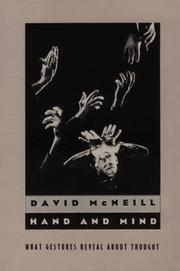| Listing 1 - 7 of 7 |
Sort by
|

ISBN: 1283358263 9786613358264 9027274738 9789027274731 1556191219 9781556191213 9027220859 9789027220851 Year: 1992 Publisher: Amsterdam ; Philadelphia : J. Benjamins Pub. Co.,
Abstract | Keywords | Export | Availability | Bookmark
 Loading...
Loading...Choose an application
- Reference Manager
- EndNote
- RefWorks (Direct export to RefWorks)
This volume on nonverbal communication studies, the most multi- and interdisciplinary contribution to this field in almost twenty years, offers numerous suggestions for further research in many hitherto unexplored areas. The twenty contributions include the most recent theoretical and empirical crosscultural studies of gestures from historical, communicative and sociopsychological perspectives. In addition the volume presents novel psychological and clinical studies of nonverbal behaviors in connection with, for instance, aphasias and children's experience of artificial limbs. A whole section
Nonverbal communication. --- Non-verbal communication --- Communication --- Expression --- Nonverbal communication --- #SBIB:309H53 --- 800.95 --- 800.95 Non-verbale communicatie --- Non-verbale communicatie --- Niet-verbale communicatie

ISBN: 080148023X Year: 1992 Publisher: Ithaca, N.Y. : Cornell University Press,
Abstract | Keywords | Export | Availability | Bookmark
 Loading...
Loading...Choose an application
- Reference Manager
- EndNote
- RefWorks (Direct export to RefWorks)
Gesture --- Gesture in art --- Gestes --- Gestes dans l'art --- History --- Histoire --- #VCV monografie 2000 --- 800.95 --- 800.95 Non-verbale communicatie --- Non-verbale communicatie --- Mudra --- Acting --- Body language --- Elocution --- Movement (Acting) --- Oratory --- Sign language

ISBN: 0226561348 0226561321 9780226561325 9780226561349 Year: 1992 Publisher: Chicago: University of Chicago press,
Abstract | Keywords | Export | Availability | Bookmark
 Loading...
Loading...Choose an application
- Reference Manager
- EndNote
- RefWorks (Direct export to RefWorks)
What is the relation between gestures and speech? In terms of symbolic forms, of course, the spontaneous and unwitting gestures we make while talking differ sharply from spoken language itself. Whereas spoken language is linear, segmented, standardized, and arbitrary, gestures are global, synthetic, idiosyncratic, and imagistic. In Hand and Mind, David McNeill presents a bold theory of the essential unity of speech and the gestures that accompany it. This long-awaited, provocative study argues that the unity of gestures and language far exceeds the surface level of speech noted by previous researchers and in fact also includes the semantic and pragmatic levels of language. In effect, the whole concept of language must be altered to take into account the nonsegmented, instantaneous, and holistic images conveyed by gestures. McNeill and his colleagues carefully devised a standard methodology for examining the speech and gesture behavior of individuals engaged in narrative discourse. A research subject is shown a cartoon like the 1950 Canary Row--a classic Sylvester and Tweedy Bird caper that features Sylvester climbing up a downspout, swallowing a bowling ball and slamming into a brick wall. After watching the cartoon, the subject is videotaped recounting the story from memory to a listener who has not seen the cartoon. Painstaking analysis of the videotapes revealed that although the research subjects--children as well as adults, some neurologically impaired--represented a wide variety of linguistic groupings, the gestures of people speaking English and a half dozen other languages manifest the same principles. Relying on data from more than ten years of research, McNeill shows thatgestures do not simply form a part of what is said and meant but have an impact on thought itself. He persuasively argues that because gestures directly transfer mental images to visible forms, conveying ideas that language cannot always express, we must examine language and gesture.
Gesture --- Thought and thinking --- Psycholinguistics --- Movement (Acting) --- Gebaren en cognitie. --- 800.95 --- #SBIB:309H53 --- Mind --- Thinking --- Thoughts --- Language, Psychology of --- Language and languages --- Psychology of language --- Speech --- Mudra --- 800.95 Non-verbale communicatie --- Non-verbale communicatie --- Niet-verbale communicatie --- Psychological aspects --- Psychology --- Educational psychology --- Philosophy --- Intellect --- Logic --- Perception --- Self --- Linguistics --- Acting --- Body language --- Elocution --- Oratory --- Sign language --- Cognitive psychology --- Semiotics --- Gesture. --- Psycholinguistics. --- Psycholinguïstiek. --- Thought and thinking. --- Body language.
Book
ISBN: 0226138089 Year: 1992 Publisher: Chicago University of Chicago Press
Abstract | Keywords | Export | Availability | Bookmark
 Loading...
Loading...Choose an application
- Reference Manager
- EndNote
- RefWorks (Direct export to RefWorks)
Affective and dynamic functions --- Sociology of culture --- 800.95 --- Costume --- -Fashion --- -Gender identity --- Group identity --- #SBIB:309H53 --- #SBIB:316.7C200 --- Collective identity --- Community identity --- Cultural identity --- Social identity --- Identity (Psychology) --- Social psychology --- Collective memory --- Sex identity (Gender identity) --- Sexual identity (Gender identity) --- Sex (Psychology) --- Queer theory --- Style in dress --- Clothing and dress --- Fancy dress --- Motion pictures --- Opera --- Stage costume --- Theater --- Theatrical costume --- Decorative arts --- Non-verbale communicatie --- Social aspects --- Niet-verbale communicatie --- Sociologie van de cultuuruitingen: algemeen --- Fashion --- Gender identity. --- Group identity. --- Social aspects. --- 800.95 Non-verbale communicatie --- Gender identity --- Society and clothing --- Gender dysphoria --- Mode --- Identité collective --- Vêtements --- Aspect social

Abstract | Keywords | Export | Availability | Bookmark
 Loading...
Loading...Choose an application
- Reference Manager
- EndNote
- RefWorks (Direct export to RefWorks)
316.773.33 --- 800.95 --- #SBIB:309H1523 --- #SBIB:309H1522 --- Informatieve boodschap. Voorlichting--(communicatiesociologie) --- Non-verbale communicatie --- Radio- en/of televisieprogramma's met een informatieve functie --- Radio- en/of televisieprogramma’s met een ideologische en spiegelfunctie --- Persian Gulf War, 1991 --- Press --- Public opinion --- Press coverage. --- Public opinion. --- History --- 800.95 Non-verbale communicatie --- 316.773.33 Informatieve boodschap. Voorlichting--(communicatiesociologie) --- Opinion, Public --- Perception, Public --- Popular opinion --- Public perception --- Public perceptions --- Judgment --- Social psychology --- Attitude (Psychology) --- Focus groups --- Reputation --- Media, News --- Media, The --- News media --- Journalism --- Publicity --- Newspapers --- Periodicals --- Desert Storm, Operation, 1991 --- Gulf War, 1991 --- Operation Desert Storm, 1991 --- War in the Gulf, 1991 --- Iraq-Kuwait Crisis, 1990-1991 --- Press coverage
Book
ISBN: 0091744644 Year: 1992 Publisher: London : Hutchinson,
Abstract | Keywords | Export | Availability | Bookmark
 Loading...
Loading...Choose an application
- Reference Manager
- EndNote
- RefWorks (Direct export to RefWorks)
Clothing and dress --- Power (Social sciences) --- Sex role --- Social status --- #SBIB:309H53 --- 800.95 --- 800.95 Non-verbale communicatie --- Non-verbale communicatie --- Social standing --- Socio-economic status --- Socioeconomic status --- Standing, Social --- Status, Social --- Prestige --- Empowerment (Social sciences) --- Political power --- Exchange theory (Sociology) --- Political science --- Social sciences --- Sociology --- Consensus (Social sciences) --- Society and clothing --- Psychological aspects --- Social aspects --- Niet-verbale communicatie --- Gender role --- Sex (Psychology) --- Sex differences (Psychology) --- Social role --- Gender expression --- Sexism --- Gender roles --- Gendered role --- Gendered roles --- Role, Gender --- Role, Gendered --- Role, Sex --- Roles, Gender --- Roles, Gendered --- Roles, Sex --- Sex roles

ISBN: 052141265X Year: 1992 Volume: vol *11 Publisher: Cambridge [England] Paris Cambridge University Press Editions de la Maison des sciences de l'homme
Abstract | Keywords | Export | Availability | Bookmark
 Loading...
Loading...Choose an application
- Reference Manager
- EndNote
- RefWorks (Direct export to RefWorks)
Primary groups --- Psycholinguistics --- Behavior [Comparative ] --- Child and parent --- Children and parents --- Communication non-verbale chez l'enfant --- Communication non-verbale chez les enfants --- Communicationn interpersonnelle chez les enfants --- Comparative behavior --- Comparative psychology --- Ethology [Comparative ] --- Intelligence of animals --- Intermenselijke communicatie bij kinderen --- Interpersonal communication in children --- Niet-verbale communicatie bij kinderen --- Nonverbal communication in children --- Ouders en kinderen --- Parent and child --- Parent-child relations --- Parents and children --- Parents et enfants --- Psychologie [Vergelijkende ] --- Psychologie comparée --- Psychology [Comparative ] --- Vergelijkende psychologie --- Psychology, Comparative --- 800.95 --- #SBIB:309H53 --- Behavior, Comparative --- Ethology, Comparative --- Zoology --- Animal behavior --- Animal intelligence --- Animal psychology --- Human behavior --- Instinct --- Children and adults --- Interpersonal relations --- Parental alienation syndrome --- Sandwich generation --- Child psychology --- Non-verbale communicatie --- Niet-verbale communicatie --- 800.95 Non-verbale communicatie --- Nonverbal communication in children. --- Interpersonal communication in children. --- Parent and child. --- Psychology, Comparative.
| Listing 1 - 7 of 7 |
Sort by
|

 Search
Search Feedback
Feedback About UniCat
About UniCat  Help
Help News
News